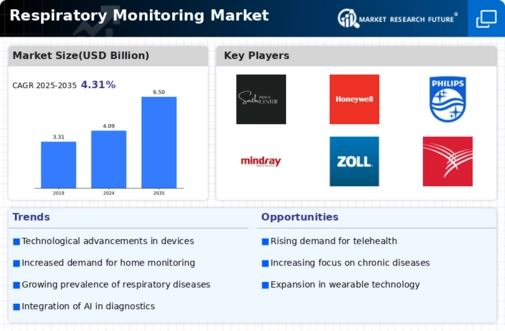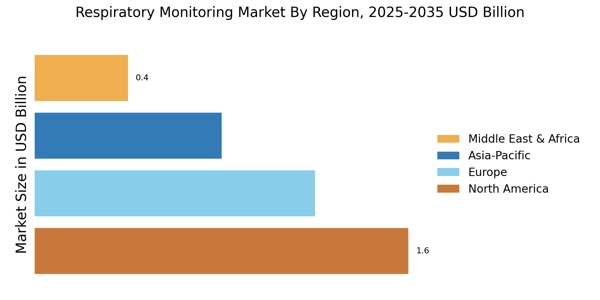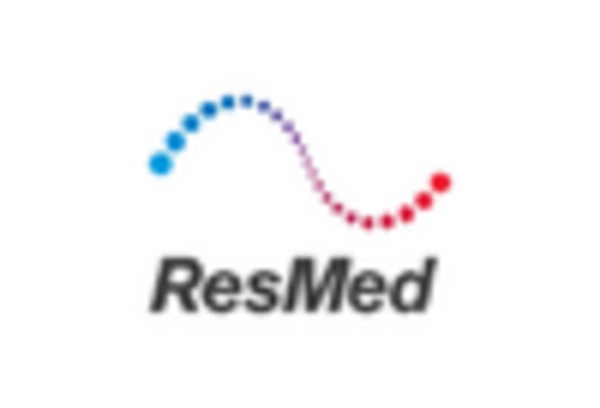Rising Demand for Home Healthcare Solutions
The shift towards home healthcare is reshaping the Respiratory Monitoring Market. As patients increasingly prefer receiving care in the comfort of their homes, the demand for home-based respiratory monitoring solutions is on the rise. This trend is supported by the growing aging population, which often requires ongoing monitoring of respiratory conditions. Market data indicates that the home healthcare segment is expected to account for a substantial share of the overall respiratory monitoring market, with projections suggesting a growth rate of approximately 8% annually. The convenience and accessibility of home monitoring devices are appealing to both patients and healthcare providers, as they facilitate continuous care and reduce hospital visits. Consequently, this shift is likely to drive innovation and investment in the Respiratory Monitoring Market, as companies develop user-friendly and effective home monitoring solutions.
Increasing Prevalence of Respiratory Diseases
The rising incidence of respiratory diseases, such as asthma and chronic obstructive pulmonary disease (COPD), is a primary driver for the Respiratory Monitoring Market. According to recent data, respiratory diseases affect millions of individuals worldwide, leading to increased healthcare costs and a growing demand for effective monitoring solutions. The need for continuous monitoring of patients with chronic respiratory conditions is becoming more pronounced, as it allows for timely interventions and improved patient outcomes. This trend is likely to propel the market forward, as healthcare providers seek advanced technologies to manage these conditions effectively. Furthermore, the increasing awareness of respiratory health among the general population is expected to contribute to the growth of the Respiratory Monitoring Market, as individuals become more proactive in seeking monitoring solutions.
Technological Innovations in Monitoring Devices
Technological advancements in respiratory monitoring devices are significantly influencing the Respiratory Monitoring Market. Innovations such as portable spirometers, wearable sensors, and mobile health applications are enhancing the ability to monitor respiratory conditions in real-time. These devices not only provide accurate data but also improve patient engagement and adherence to treatment plans. The market for these advanced devices is projected to grow, with estimates suggesting a compound annual growth rate (CAGR) of over 10% in the coming years. As manufacturers continue to invest in research and development, the introduction of more sophisticated monitoring solutions is anticipated, further driving the Respiratory Monitoring Market. The integration of artificial intelligence and machine learning into these devices may also enhance predictive analytics, allowing for better management of respiratory diseases.
Government Initiatives and Funding for Respiratory Health
Government initiatives aimed at improving respiratory health are playing a crucial role in driving the Respiratory Monitoring Market. Various health organizations and government bodies are implementing programs to raise awareness about respiratory diseases and promote early detection and management. Funding for research and development in respiratory monitoring technologies is also increasing, as governments recognize the need for effective solutions to combat the rising burden of respiratory illnesses. Market data suggests that public funding for respiratory health initiatives is projected to grow, potentially exceeding several billion dollars in the coming years. This financial support is likely to encourage innovation and development within the Respiratory Monitoring Market, as companies seek to align their products with government health objectives and improve patient outcomes.
Integration of Artificial Intelligence in Monitoring Systems
The incorporation of artificial intelligence (AI) into respiratory monitoring systems is emerging as a key driver for the Respiratory Monitoring Market. AI technologies enable more accurate data analysis and predictive modeling, which can significantly enhance patient care. By utilizing machine learning algorithms, healthcare providers can identify patterns and trends in respiratory data, leading to more personalized treatment plans. The market for AI-driven respiratory monitoring solutions is expected to expand rapidly, with estimates indicating a potential growth rate of over 15% in the next few years. This integration not only improves the efficiency of monitoring systems but also empowers healthcare professionals to make informed decisions based on real-time data. As the demand for advanced monitoring solutions continues to rise, the role of AI in the Respiratory Monitoring Market is likely to become increasingly prominent.


















Leave a Comment